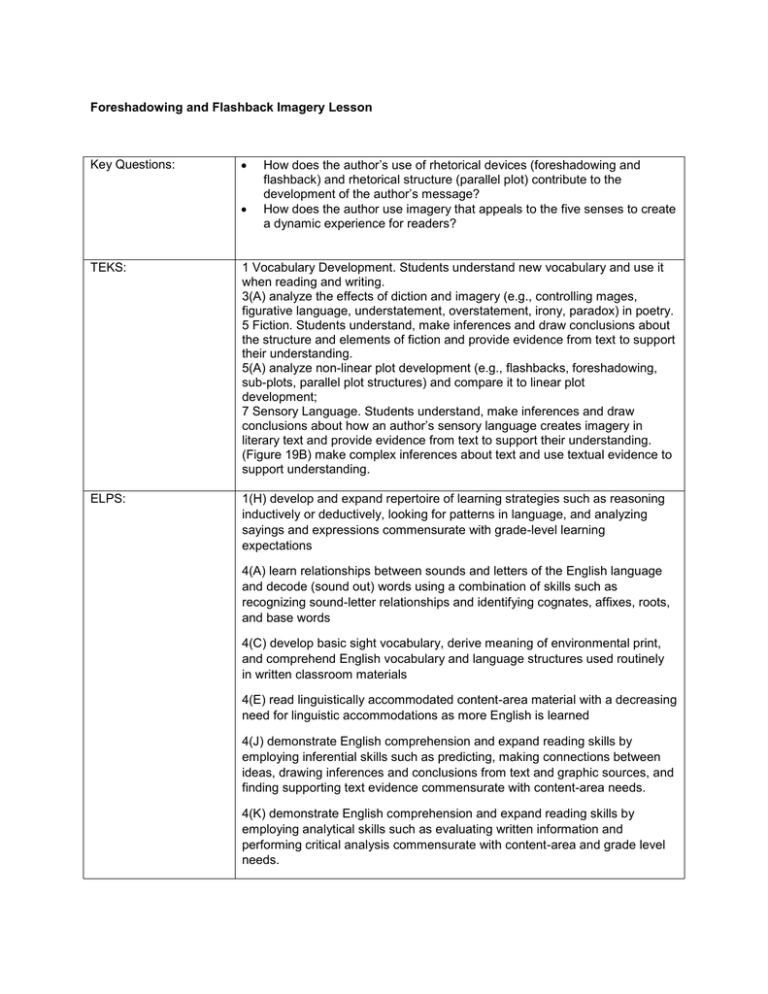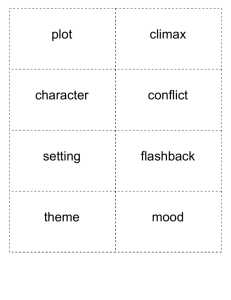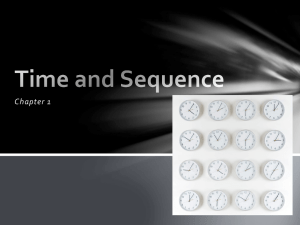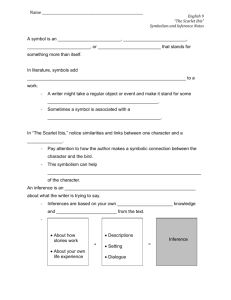File - Andrea Galvan E-Portfolio
advertisement

Foreshadowing and Flashback Imagery Lesson Key Questions: How does the author’s use of rhetorical devices (foreshadowing and flashback) and rhetorical structure (parallel plot) contribute to the development of the author’s message? How does the author use imagery that appeals to the five senses to create a dynamic experience for readers? TEKS: 1 Vocabulary Development. Students understand new vocabulary and use it when reading and writing. 3(A) analyze the effects of diction and imagery (e.g., controlling mages, figurative language, understatement, overstatement, irony, paradox) in poetry. 5 Fiction. Students understand, make inferences and draw conclusions about the structure and elements of fiction and provide evidence from text to support their understanding. 5(A) analyze non-linear plot development (e.g., flashbacks, foreshadowing, sub-plots, parallel plot structures) and compare it to linear plot development; 7 Sensory Language. Students understand, make inferences and draw conclusions about how an author’s sensory language creates imagery in literary text and provide evidence from text to support their understanding. (Figure 19B) make complex inferences about text and use textual evidence to support understanding. ELPS: 1(H) develop and expand repertoire of learning strategies such as reasoning inductively or deductively, looking for patterns in language, and analyzing sayings and expressions commensurate with grade-level learning expectations 4(A) learn relationships between sounds and letters of the English language and decode (sound out) words using a combination of skills such as recognizing sound-letter relationships and identifying cognates, affixes, roots, and base words 4(C) develop basic sight vocabulary, derive meaning of environmental print, and comprehend English vocabulary and language structures used routinely in written classroom materials 4(E) read linguistically accommodated content-area material with a decreasing need for linguistic accommodations as more English is learned 4(J) demonstrate English comprehension and expand reading skills by employing inferential skills such as predicting, making connections between ideas, drawing inferences and conclusions from text and graphic sources, and finding supporting text evidence commensurate with content-area needs. 4(K) demonstrate English comprehension and expand reading skills by employing analytical skills such as evaluating written information and performing critical analysis commensurate with content-area and grade level needs. Concepts / Skills Reading to be taught: The students will be taught how to identify foreshadowing and flashback through the reading of a short work of fiction The students will learn to extract important information from a selected reading Writing TEKS Vocabulary: Complete and/or correct select portions of a work of fiction to identify flashback and foreshadowing. The students will learn to write concise responses to short answer responses Flashback Foreshadow Imagery Inference Literature / Resources: 1. “The Scarlet Ibis” – Holt DVD Video Trailer 2. Vocabulary Study: Words in Context – attached 3. James Hurst’s excerpt from short story “The Scarlet Ibis” p. 462-475 – purple Holt textbook 4. “The Scarlet Ibis” Discussion Review PowerPoint 5. Flashback and Foreshadowing Timeline - attached 6. Flashback and Foreshadowing Practice Exercises (see below): a. Practice 1 – “The Grasshopper and the Ant” b. Practice 2 – “The Fall of the House of Usher” c. Practice 3 – “Signs of the Times” 7. 3x5 index cards (10 lines like a SAR response box) 8. Teachers may substitute other relevant stories to provide a range of reading and level of text complexity. Considerations for Struggling Students: Lesson: James Hurst’s excerpt from short story “The Scarlet Ibis” p. 190-204 in Holt Interactive Reader, or p. 186-196 in the Holt ELL Adapted Interactive Reader Use audio version of text Shelter instruction Provide Bilingual and English Language Dictionaries Model reading strategies Use graphic organizers Provide extensive scaffolding Employ reciprocal teaching Allow extra time for assignments Duration: Approximately 3 days SEE 1. Show students the video trailer to “The Scarlet Ibis” – Holt DVD. 2. Tell students that as they read, they should consider the nonlinear plot development, imagery, and how these devices help contribute to author’s purpose. DO 3. Complete the prediction portion of the Vocabulary sheet (attached) 4. Introduce James Hurst’s story “The Scarlet Ibis” (textbook) 5. Students listen as story is read aloud by teacher or by listening to Holt Audio CD. (Alternatively the story can be read as a whole class, pausing as needed to check for understanding or to answer questions). 6. After reading story, complete the meaning portion of the Vocabulary sheet (attached) SEE/DO/TALK 7. Review story using “The Scarlet Ibis” Discussion Review PowerPoint 8. Have students complete the Flashback and Foreshadowing Timeline activity (attached) DO 9. Students will complete the following warm-up: Define imagery. Provide examples of at least three death images in the story. SEE/DO/TALK 10. Introduce Inference Class Activity - Explain: When you make an inference, you make a logical guess based on observations or information in a text combined with your own knowledge and experience. Making an inference about a character is making a logical guess based on what the character says and does as well as what others say and do about that character. Making inferences about characters can help you better understand the characters and the story. 11. Then as a class: Fill in the chart with quotes from the story that have to do with the relationship between the narrator and Doodle. Record student inferences about the relationship based on the quotes. Quotes “Doodle was a nice crazy, like someone you meet in your dreams.” Inferences about Relationship Narrator basically liked his brother, but thought he was odd. (lines _____) 12. Give each student a 3x5 index card and have them respond to the following: Identify two or more examples of imagery that combine effectively to create a certain atmosphere or mood in the story. Support your answer with evidence from the text. TRANSFER 13. Have students complete the Flashback and Foreshadowing Practice Exercises (attached). Additional Resources: STORY TIMELINE: SEQUENCE OF EVENTS The narrator looks back at a period that spans close to seven years. Have students construct a timeline, perhaps using multiple sheets of paper, to cover this time span. Ask students to label the timeline with story events above the line and political or world events mentioned in the story (for example, the presidency of Woodrow Wilson) beneath it. Have students use their timeline to present the chronology of events to the class. Assessment/Evaluation 1. Student accurately explains foreshadowing, flashback and imagery. 2. Student accurately cites textual evidence to support the responses. 3. Student can explain why it is important to support their responses with textual evidence. 4. Student accurately analyzes figurative language and can critique the author’s motivation for its use. 5. Student accurately distinguishes between fact and inference.





